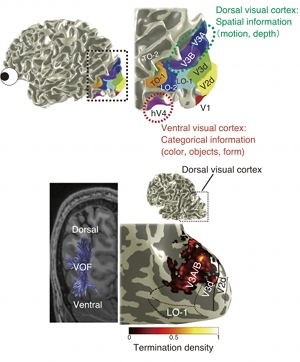In our daily life, our visual system constantly integrates various types of visual information such as color, shape and motion. For example, when we are reading a textbook, we need to quickly and accurately integrate the spatial position information and the form information of the text we read. The human brain has distinct brain regions involved in processing spatial information such as motion and depth, and other regions involved in processing categorical information such as color, form and objects. However, these regions are located several centimeters away in the dorsal and ventral parts of the human visual cortex. How does the dorsal and ventral visual cortex communicate with each other, in order to integrate the spatial information of color, form and objects?
In this research, Hiromasa Takemura and colleagues used fMRI and diffusion MRI (dMRI) to identify how the white matter pathway links the cortical regions within the dorsal and ventral visual cortex. First, they identified the cortical visual areas of interest using fMRI.

Second, they collected diffusion MRI data from the same participants, and performed fiber tractography to identify the white matter pathway communicating the dorsal and ventral visual cortex in humans. As a result, they identified the Vertical Occipital Fasciculus (VOF), which is a white matter pathway connecting the dorsal and lateral side of the ventral visual cortex in all individual brains. The existence of this pathway has been reported in classical studies on post-mortem brains, but largely ignored in the literature (Yeatman et al., 2014). More importantly, they analyzed the relationship between cortical visual areas and the VOF termination, and found that the VOF terminates near the area V3A/B in the dorsal visual cortex and the area hV4/VO-1 in ventral visual cortex. Based on previous studies, V3A/B is known to be a region involved with processing motion and depth information, whereas hV4/VO-1 is known to be involved with the processing of colors. This study highlights the importance of the VOF in integrating spatial and categorical information, a crucial function in many aspects of daily life vision. Characterizing the VOF in individual brains will provide the opportunity for further understanding how signals travels between the dorsal and ventral visual cortex, and how those signals supports our daily vision in health and disease.
This paper appeared in the journal Cerebral Cortex on January 9, 2015.
Full Reference:
“A Major Human White Matter Pathway Between Dorsal and Ventral Visual Cortex”
Hiromasa Takemura, Ariel Rokem, Jonathan Winawer, Jason D. Yeatman, Brian A. Wandell, Franco Pestilli
Cerebal Cortex (2015) doi: 10.1093/cercor/bhv064
http://cercor.oxfordjournals.org/content/early/2015/03/30/cercor.bhv064.abstract
